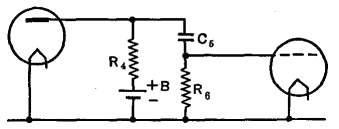| Basic Radio is a free introductory textbook on electronics based on tubes. See the editorial for more information.... |

|

Home  Amplifiers Amplifiers  Audio-Frequency Amplifiers Audio-Frequency Amplifiers  R and C Values R and C Values |
||||||||||||||||||||||||||||||






|
||||||||||||||||||||||||||||||
|
R and C ValuesAuthor: J.B. Hoag Let us next consider the numerical values of the various resistors and condensers, together with the reasons for these values.
The screen resistor is chosen of such a value that, subtracting the voltage drop in it due to the screen-grid current, the correct voltage is left for the screen grid. Values from 0.25 to 2 megohms are used. A screen bypass condenser of 0.1 µfd. will suffice in most cases. The value of the cathode or C-bias resistor is determined by the voltage needed for the grid of the tube. It must be remembered that the screen, as well as the plate currents, flow through this resistor. Values range from 500 to 10,000 ohms. It should be obvious by now, that to design an amplifier, one first chooses the type of circuit, with characteristics most suited to the job at hand; then the tube, with its proper operating voltages supplied by the manufacturer; and finally the values of the resistors and condensers, both to fit the tube and to yield the desired characteristics. Typical values of R2, R3, and R4 follow:
The decoupling circuit C4R5 of Fig. 25 A is intended to keep the a.c. out of the power supply by bypassing the a.c. through C4 and offering as high a resistance in R5 as practicable for the B voltage available. (Remember that the loss of voltage in R5 is due to plate plus screen currents.) The reactance, 1/2µfC4, is to be as small as possible for the frequencies being amplified. For low frequencies, C4 must be large, and vice versa. The C4R5 circuit is often the cause of low frequency oscillations in multistage R-C amplifiers. When this occurs, the circuit is said to be "motor boating". The C-bias bypass condenser (C2) must have as low a reactance as possible in comparison to the resistor R2 for the frequencies to be amplified. Since the reactance, 1/2µfC2, is greater at the lower frequencies, some of the currents at these frequencies will be lost in this part of the circuit. For values of R2 around 10,000 ohms, C2 can be from 1 to 10 µfd., while with R2 around 500 ohms, a value of 10 µfd. should be used for audio-frequency amplifiers. Electrolytic condensers, which are compact and inexpensive, serve nicely for C2. A typical frequency response curve of an R-C coupled amplifier is given in Fig. 25 B, where it will be noted that the amplification is poor for the lower and for the higher frequencies. The reason for the lowered amplification at the higher frequencies is, chiefly, in the shunting effect of the tube's internal capacitances. Although these capacitances (effective value C1) may be small, still their reactance, 1/2µfC1, becomes sufficiently high when f has increased that the input signal fails to give voltages on the grid commensurate with those at lower frequencies.
Part of the reason for the drop at the lower end of Fig. 25 B is due to the ineffectiveness of C2 (Fig. 25 A) in bypassing the signal around R2, as mentioned before; but the major reason lies in the output coupling condenser C5. This will be easily understood if we redraw the coupling circuit in the form of Fig. 25 C.
Here we see that the a.c. voltage developed across the plate resistor R4 is divided between C5 and R6. Only that across R6 is applied to the grid of the next tube. Hence, at the lower frequencies, where the reactance (1/2µfC5) is large, the per cent of the total voltage across R4 which occurs across R6 is less than at the higher frequencies. Usually, a coupling condenser (C5) of 0.1 µfd. is used in audio-frequency amplifiers. It must be capable of withstanding the full plate voltage and must have excellent insulation so that there shall be no leakage through it. A leaky condenser at this point in the circuit will allow a small current to flow through the high-resistance grid resistor (R6) and establish a positive potential on the grid of the following tube. This could be counterbalanced by increasing the C-bias; but leakage currents are often quite erratic and a well-insulated condenser should be used. The grid resistor R6 should be as large as possible without "blocking" the next tube. Blocking means that the time constant R6C5 is so great that electrons on the grid do not have time to leak off of C5 through R6. Then the grid goes negative to such a value that the plate current is shut off or "blocked". R6 ranges from 50,000 ohms for power tubes such as the 2A3 or 6F6, up to 1 megohm for other tubes.
|
||||||||||||||||||||||||||||||
Home  Amplifiers Amplifiers  Audio-Frequency Amplifiers Audio-Frequency Amplifiers  R and C Values R and C Values |
||||||||||||||||||||||||||||||
Last Update: 2009-11-01



